Financial Resource Management Report: Analysis of Financial Statements
VerifiedAdded on 2020/10/22
|10
|2972
|260
Report
AI Summary
This report delves into the intricacies of financial resource management, beginning with a comparison between financial and management accounts, highlighting their distinct purposes and applications. It then explores the vital objectives of utilizing financial statements, differentiating between profit-oriented and non-profit organizations. The report proceeds to analyze various stakeholder groups and the critical data they require for decision-making. Furthermore, it undertakes a detailed examination of the financial performance of "Poundland Group Plc." through the calculation and interpretation of key financial ratios such as ROCE, current ratio, and gearing ratio. The analysis covers the years 2015 and 2016, offering insights into the company's financial health and performance trends. The report emphasizes the importance of financial data for stakeholders and the role of financial statements in assessing organizational growth and development.
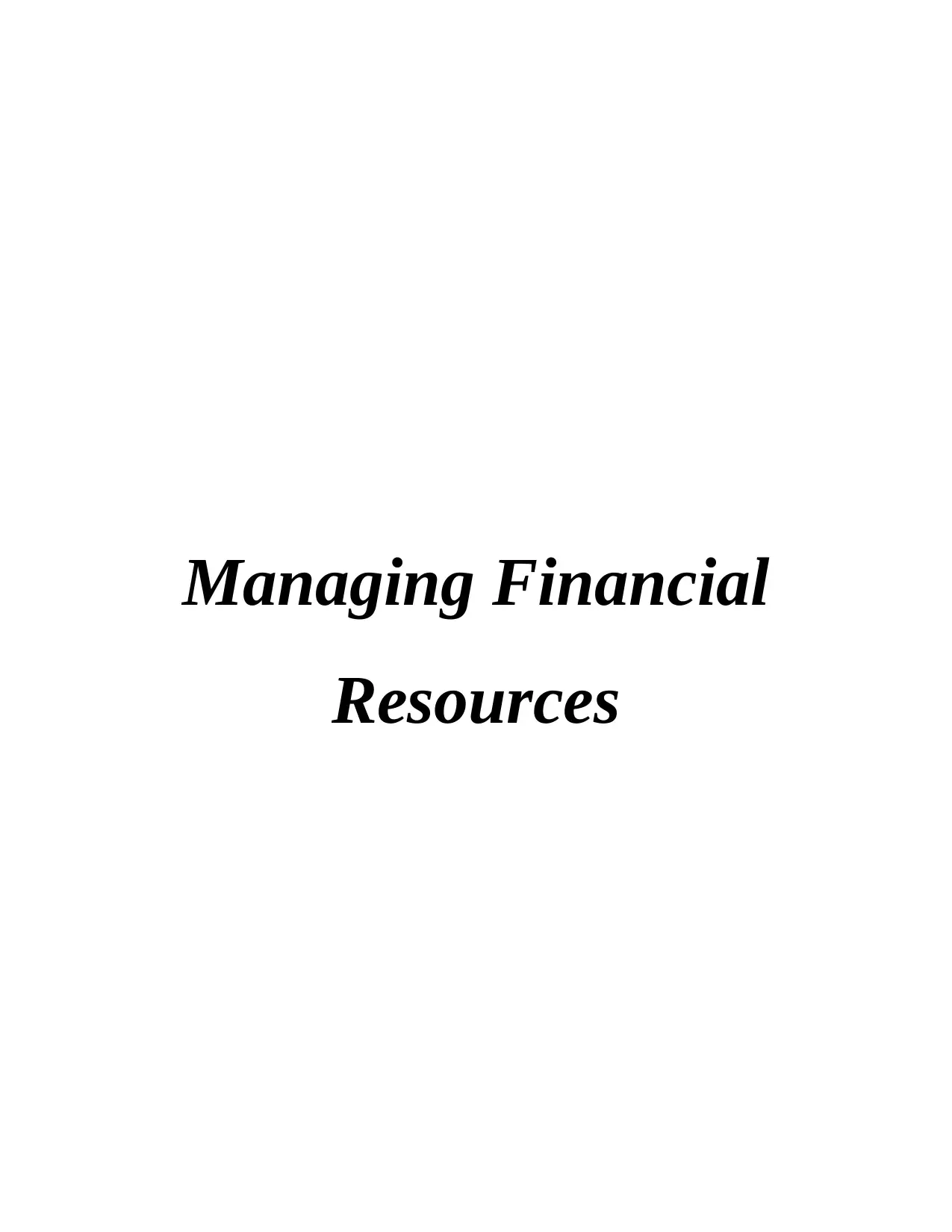
Managing Financial
Resources
Resources
Paraphrase This Document
Need a fresh take? Get an instant paraphrase of this document with our AI Paraphraser
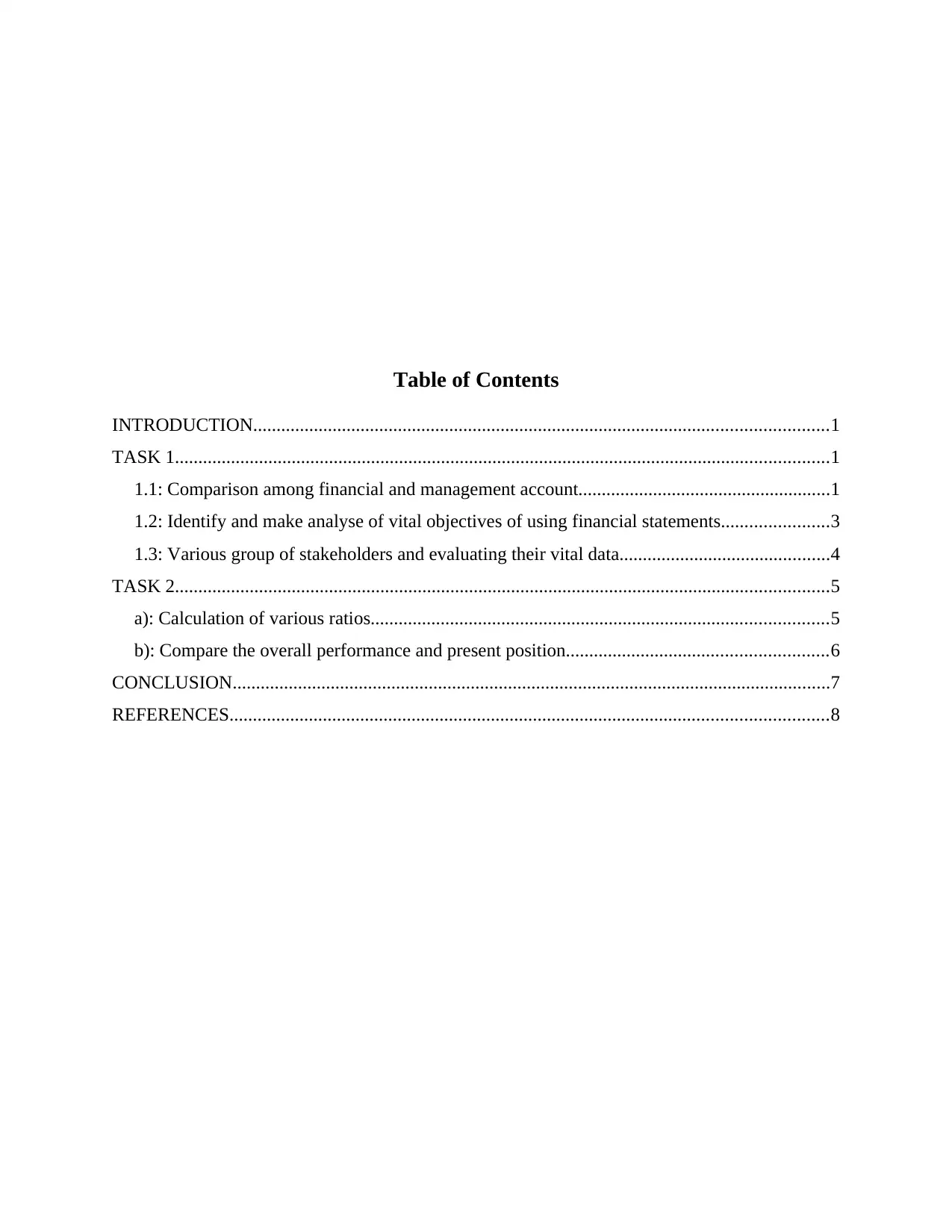
Table of Contents
INTRODUCTION...........................................................................................................................1
TASK 1............................................................................................................................................1
1.1: Comparison among financial and management account......................................................1
1.2: Identify and make analyse of vital objectives of using financial statements.......................3
1.3: Various group of stakeholders and evaluating their vital data.............................................4
TASK 2............................................................................................................................................5
a): Calculation of various ratios..................................................................................................5
b): Compare the overall performance and present position........................................................6
CONCLUSION................................................................................................................................7
REFERENCES................................................................................................................................8
INTRODUCTION...........................................................................................................................1
TASK 1............................................................................................................................................1
1.1: Comparison among financial and management account......................................................1
1.2: Identify and make analyse of vital objectives of using financial statements.......................3
1.3: Various group of stakeholders and evaluating their vital data.............................................4
TASK 2............................................................................................................................................5
a): Calculation of various ratios..................................................................................................5
b): Compare the overall performance and present position........................................................6
CONCLUSION................................................................................................................................7
REFERENCES................................................................................................................................8
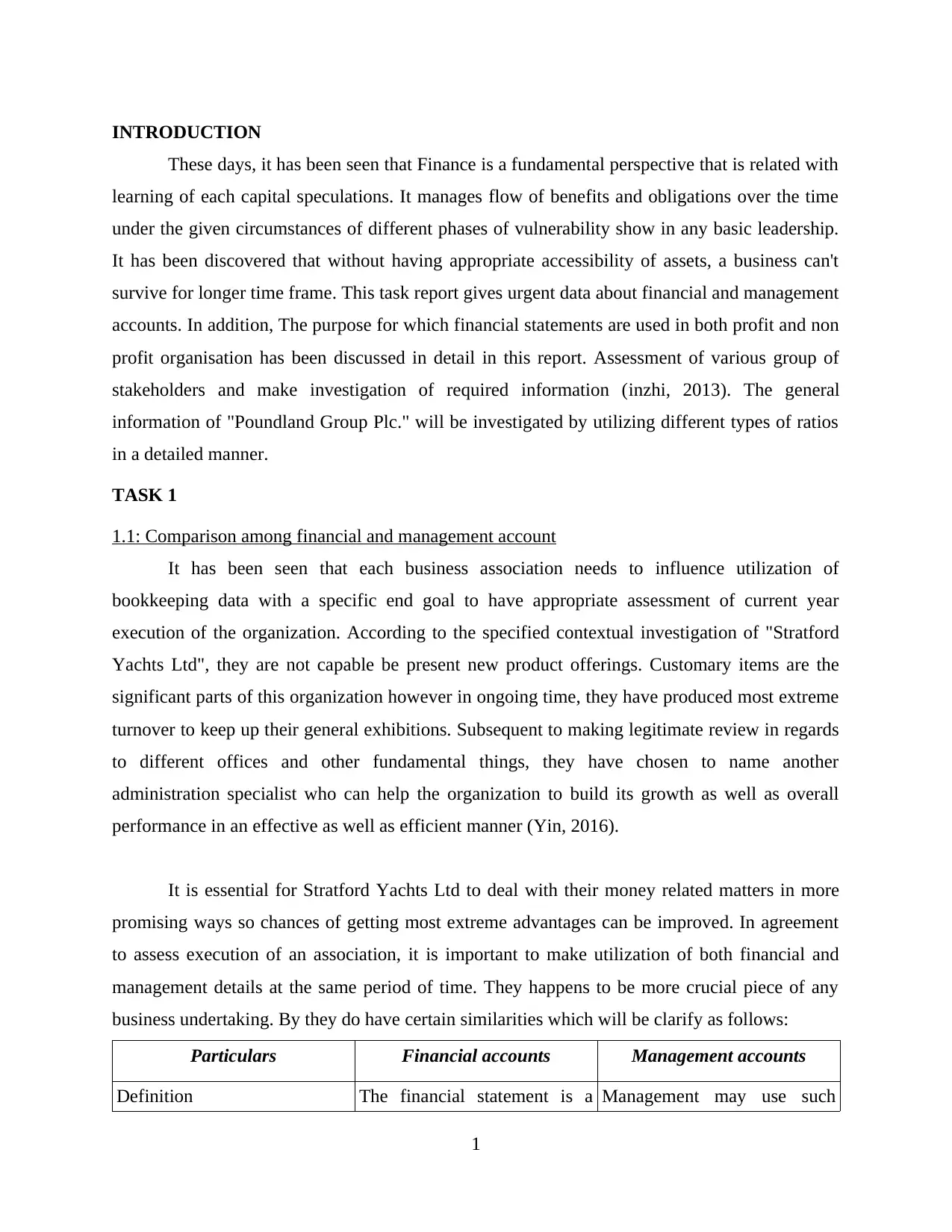
INTRODUCTION
These days, it has been seen that Finance is a fundamental perspective that is related with
learning of each capital speculations. It manages flow of benefits and obligations over the time
under the given circumstances of different phases of vulnerability show in any basic leadership.
It has been discovered that without having appropriate accessibility of assets, a business can't
survive for longer time frame. This task report gives urgent data about financial and management
accounts. In addition, The purpose for which financial statements are used in both profit and non
profit organisation has been discussed in detail in this report. Assessment of various group of
stakeholders and make investigation of required information (inzhi, 2013). The general
information of "Poundland Group Plc." will be investigated by utilizing different types of ratios
in a detailed manner.
TASK 1
1.1: Comparison among financial and management account
It has been seen that each business association needs to influence utilization of
bookkeeping data with a specific end goal to have appropriate assessment of current year
execution of the organization. According to the specified contextual investigation of "Stratford
Yachts Ltd", they are not capable be present new product offerings. Customary items are the
significant parts of this organization however in ongoing time, they have produced most extreme
turnover to keep up their general exhibitions. Subsequent to making legitimate review in regards
to different offices and other fundamental things, they have chosen to name another
administration specialist who can help the organization to build its growth as well as overall
performance in an effective as well as efficient manner (Yin, 2016).
It is essential for Stratford Yachts Ltd to deal with their money related matters in more
promising ways so chances of getting most extreme advantages can be improved. In agreement
to assess execution of an association, it is important to make utilization of both financial and
management details at the same period of time. They happens to be more crucial piece of any
business undertaking. By they do have certain similarities which will be clarify as follows:
Particulars Financial accounts Management accounts
Definition The financial statement is a Management may use such
1
These days, it has been seen that Finance is a fundamental perspective that is related with
learning of each capital speculations. It manages flow of benefits and obligations over the time
under the given circumstances of different phases of vulnerability show in any basic leadership.
It has been discovered that without having appropriate accessibility of assets, a business can't
survive for longer time frame. This task report gives urgent data about financial and management
accounts. In addition, The purpose for which financial statements are used in both profit and non
profit organisation has been discussed in detail in this report. Assessment of various group of
stakeholders and make investigation of required information (inzhi, 2013). The general
information of "Poundland Group Plc." will be investigated by utilizing different types of ratios
in a detailed manner.
TASK 1
1.1: Comparison among financial and management account
It has been seen that each business association needs to influence utilization of
bookkeeping data with a specific end goal to have appropriate assessment of current year
execution of the organization. According to the specified contextual investigation of "Stratford
Yachts Ltd", they are not capable be present new product offerings. Customary items are the
significant parts of this organization however in ongoing time, they have produced most extreme
turnover to keep up their general exhibitions. Subsequent to making legitimate review in regards
to different offices and other fundamental things, they have chosen to name another
administration specialist who can help the organization to build its growth as well as overall
performance in an effective as well as efficient manner (Yin, 2016).
It is essential for Stratford Yachts Ltd to deal with their money related matters in more
promising ways so chances of getting most extreme advantages can be improved. In agreement
to assess execution of an association, it is important to make utilization of both financial and
management details at the same period of time. They happens to be more crucial piece of any
business undertaking. By they do have certain similarities which will be clarify as follows:
Particulars Financial accounts Management accounts
Definition The financial statement is a Management may use such
1
⊘ This is a preview!⊘
Do you want full access?
Subscribe today to unlock all pages.

Trusted by 1+ million students worldwide
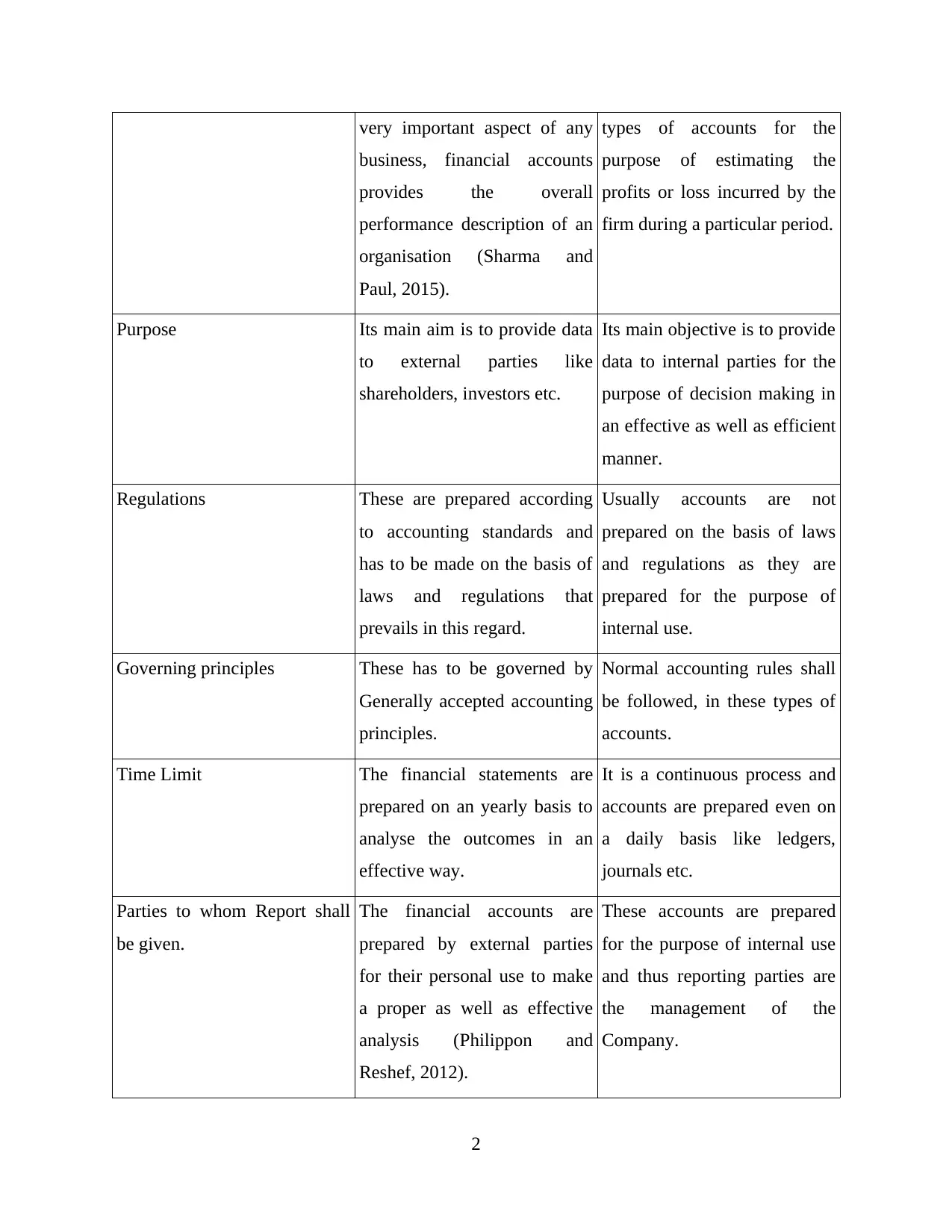
very important aspect of any
business, financial accounts
provides the overall
performance description of an
organisation (Sharma and
Paul, 2015).
types of accounts for the
purpose of estimating the
profits or loss incurred by the
firm during a particular period.
Purpose Its main aim is to provide data
to external parties like
shareholders, investors etc.
Its main objective is to provide
data to internal parties for the
purpose of decision making in
an effective as well as efficient
manner.
Regulations These are prepared according
to accounting standards and
has to be made on the basis of
laws and regulations that
prevails in this regard.
Usually accounts are not
prepared on the basis of laws
and regulations as they are
prepared for the purpose of
internal use.
Governing principles These has to be governed by
Generally accepted accounting
principles.
Normal accounting rules shall
be followed, in these types of
accounts.
Time Limit The financial statements are
prepared on an yearly basis to
analyse the outcomes in an
effective way.
It is a continuous process and
accounts are prepared even on
a daily basis like ledgers,
journals etc.
Parties to whom Report shall
be given.
The financial accounts are
prepared by external parties
for their personal use to make
a proper as well as effective
analysis (Philippon and
Reshef, 2012).
These accounts are prepared
for the purpose of internal use
and thus reporting parties are
the management of the
Company.
2
business, financial accounts
provides the overall
performance description of an
organisation (Sharma and
Paul, 2015).
types of accounts for the
purpose of estimating the
profits or loss incurred by the
firm during a particular period.
Purpose Its main aim is to provide data
to external parties like
shareholders, investors etc.
Its main objective is to provide
data to internal parties for the
purpose of decision making in
an effective as well as efficient
manner.
Regulations These are prepared according
to accounting standards and
has to be made on the basis of
laws and regulations that
prevails in this regard.
Usually accounts are not
prepared on the basis of laws
and regulations as they are
prepared for the purpose of
internal use.
Governing principles These has to be governed by
Generally accepted accounting
principles.
Normal accounting rules shall
be followed, in these types of
accounts.
Time Limit The financial statements are
prepared on an yearly basis to
analyse the outcomes in an
effective way.
It is a continuous process and
accounts are prepared even on
a daily basis like ledgers,
journals etc.
Parties to whom Report shall
be given.
The financial accounts are
prepared by external parties
for their personal use to make
a proper as well as effective
analysis (Philippon and
Reshef, 2012).
These accounts are prepared
for the purpose of internal use
and thus reporting parties are
the management of the
Company.
2
Paraphrase This Document
Need a fresh take? Get an instant paraphrase of this document with our AI Paraphraser
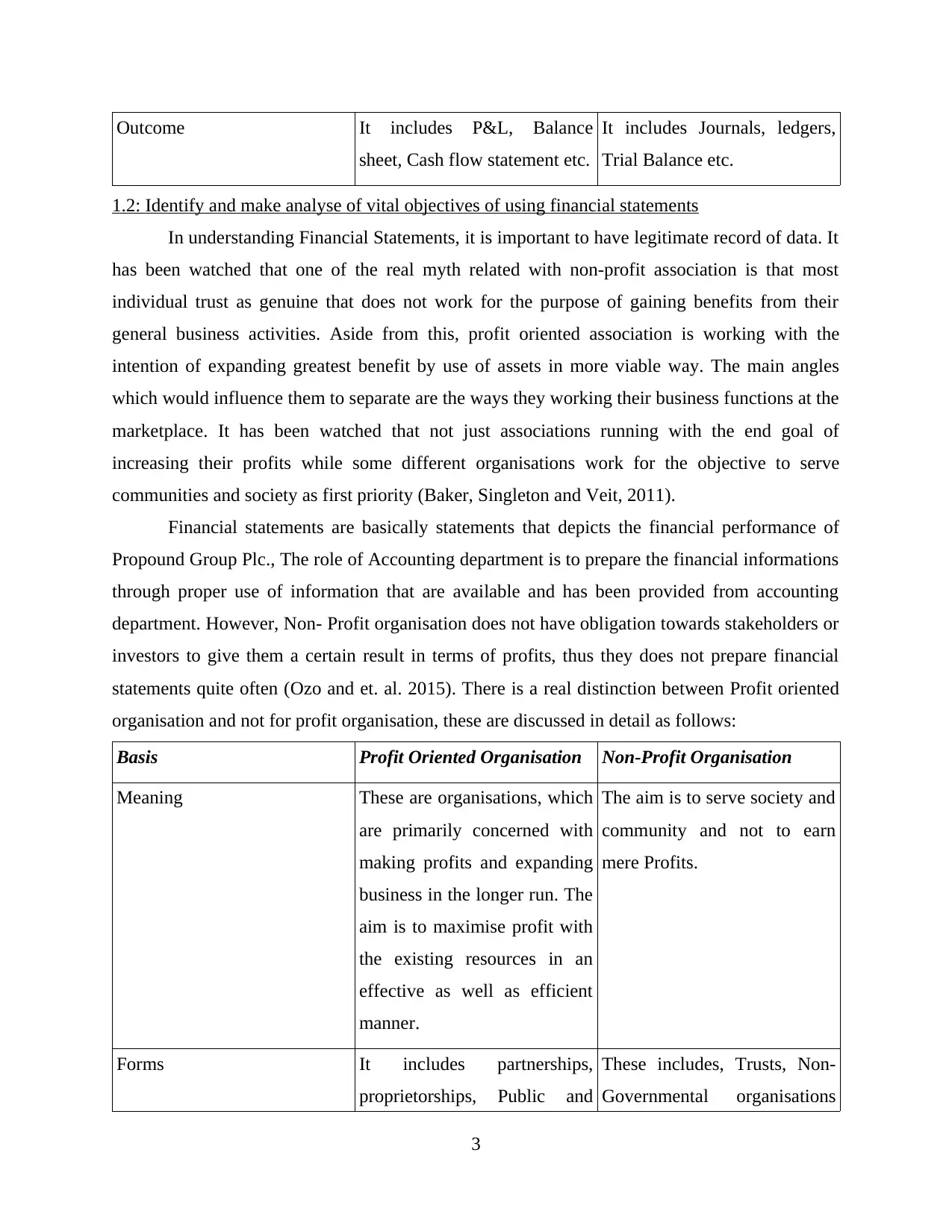
Outcome It includes P&L, Balance
sheet, Cash flow statement etc.
It includes Journals, ledgers,
Trial Balance etc.
1.2: Identify and make analyse of vital objectives of using financial statements
In understanding Financial Statements, it is important to have legitimate record of data. It
has been watched that one of the real myth related with non-profit association is that most
individual trust as genuine that does not work for the purpose of gaining benefits from their
general business activities. Aside from this, profit oriented association is working with the
intention of expanding greatest benefit by use of assets in more viable way. The main angles
which would influence them to separate are the ways they working their business functions at the
marketplace. It has been watched that not just associations running with the end goal of
increasing their profits while some different organisations work for the objective to serve
communities and society as first priority (Baker, Singleton and Veit, 2011).
Financial statements are basically statements that depicts the financial performance of
Propound Group Plc., The role of Accounting department is to prepare the financial informations
through proper use of information that are available and has been provided from accounting
department. However, Non- Profit organisation does not have obligation towards stakeholders or
investors to give them a certain result in terms of profits, thus they does not prepare financial
statements quite often (Ozo and et. al. 2015). There is a real distinction between Profit oriented
organisation and not for profit organisation, these are discussed in detail as follows:
Basis Profit Oriented Organisation Non-Profit Organisation
Meaning These are organisations, which
are primarily concerned with
making profits and expanding
business in the longer run. The
aim is to maximise profit with
the existing resources in an
effective as well as efficient
manner.
The aim is to serve society and
community and not to earn
mere Profits.
Forms It includes partnerships,
proprietorships, Public and
These includes, Trusts, Non-
Governmental organisations
3
sheet, Cash flow statement etc.
It includes Journals, ledgers,
Trial Balance etc.
1.2: Identify and make analyse of vital objectives of using financial statements
In understanding Financial Statements, it is important to have legitimate record of data. It
has been watched that one of the real myth related with non-profit association is that most
individual trust as genuine that does not work for the purpose of gaining benefits from their
general business activities. Aside from this, profit oriented association is working with the
intention of expanding greatest benefit by use of assets in more viable way. The main angles
which would influence them to separate are the ways they working their business functions at the
marketplace. It has been watched that not just associations running with the end goal of
increasing their profits while some different organisations work for the objective to serve
communities and society as first priority (Baker, Singleton and Veit, 2011).
Financial statements are basically statements that depicts the financial performance of
Propound Group Plc., The role of Accounting department is to prepare the financial informations
through proper use of information that are available and has been provided from accounting
department. However, Non- Profit organisation does not have obligation towards stakeholders or
investors to give them a certain result in terms of profits, thus they does not prepare financial
statements quite often (Ozo and et. al. 2015). There is a real distinction between Profit oriented
organisation and not for profit organisation, these are discussed in detail as follows:
Basis Profit Oriented Organisation Non-Profit Organisation
Meaning These are organisations, which
are primarily concerned with
making profits and expanding
business in the longer run. The
aim is to maximise profit with
the existing resources in an
effective as well as efficient
manner.
The aim is to serve society and
community and not to earn
mere Profits.
Forms It includes partnerships,
proprietorships, Public and
These includes, Trusts, Non-
Governmental organisations
3
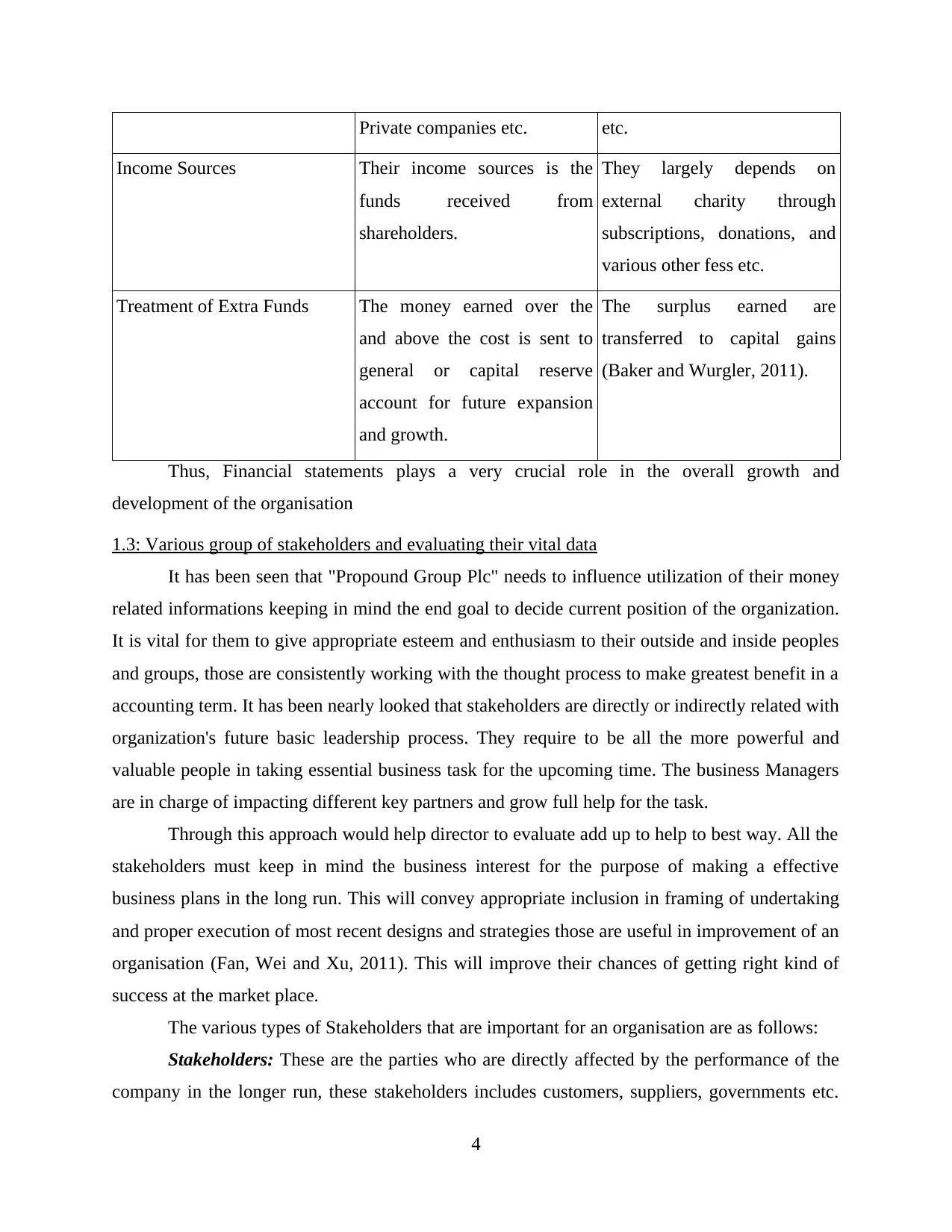
Private companies etc. etc.
Income Sources Their income sources is the
funds received from
shareholders.
They largely depends on
external charity through
subscriptions, donations, and
various other fess etc.
Treatment of Extra Funds The money earned over the
and above the cost is sent to
general or capital reserve
account for future expansion
and growth.
The surplus earned are
transferred to capital gains
(Baker and Wurgler, 2011).
Thus, Financial statements plays a very crucial role in the overall growth and
development of the organisation
1.3: Various group of stakeholders and evaluating their vital data
It has been seen that "Propound Group Plc" needs to influence utilization of their money
related informations keeping in mind the end goal to decide current position of the organization.
It is vital for them to give appropriate esteem and enthusiasm to their outside and inside peoples
and groups, those are consistently working with the thought process to make greatest benefit in a
accounting term. It has been nearly looked that stakeholders are directly or indirectly related with
organization's future basic leadership process. They require to be all the more powerful and
valuable people in taking essential business task for the upcoming time. The business Managers
are in charge of impacting different key partners and grow full help for the task.
Through this approach would help director to evaluate add up to help to best way. All the
stakeholders must keep in mind the business interest for the purpose of making a effective
business plans in the long run. This will convey appropriate inclusion in framing of undertaking
and proper execution of most recent designs and strategies those are useful in improvement of an
organisation (Fan, Wei and Xu, 2011). This will improve their chances of getting right kind of
success at the market place.
The various types of Stakeholders that are important for an organisation are as follows:
Stakeholders: These are the parties who are directly affected by the performance of the
company in the longer run, these stakeholders includes customers, suppliers, governments etc.
4
Income Sources Their income sources is the
funds received from
shareholders.
They largely depends on
external charity through
subscriptions, donations, and
various other fess etc.
Treatment of Extra Funds The money earned over the
and above the cost is sent to
general or capital reserve
account for future expansion
and growth.
The surplus earned are
transferred to capital gains
(Baker and Wurgler, 2011).
Thus, Financial statements plays a very crucial role in the overall growth and
development of the organisation
1.3: Various group of stakeholders and evaluating their vital data
It has been seen that "Propound Group Plc" needs to influence utilization of their money
related informations keeping in mind the end goal to decide current position of the organization.
It is vital for them to give appropriate esteem and enthusiasm to their outside and inside peoples
and groups, those are consistently working with the thought process to make greatest benefit in a
accounting term. It has been nearly looked that stakeholders are directly or indirectly related with
organization's future basic leadership process. They require to be all the more powerful and
valuable people in taking essential business task for the upcoming time. The business Managers
are in charge of impacting different key partners and grow full help for the task.
Through this approach would help director to evaluate add up to help to best way. All the
stakeholders must keep in mind the business interest for the purpose of making a effective
business plans in the long run. This will convey appropriate inclusion in framing of undertaking
and proper execution of most recent designs and strategies those are useful in improvement of an
organisation (Fan, Wei and Xu, 2011). This will improve their chances of getting right kind of
success at the market place.
The various types of Stakeholders that are important for an organisation are as follows:
Stakeholders: These are the parties who are directly affected by the performance of the
company in the longer run, these stakeholders includes customers, suppliers, governments etc.
4
⊘ This is a preview!⊘
Do you want full access?
Subscribe today to unlock all pages.

Trusted by 1+ million students worldwide
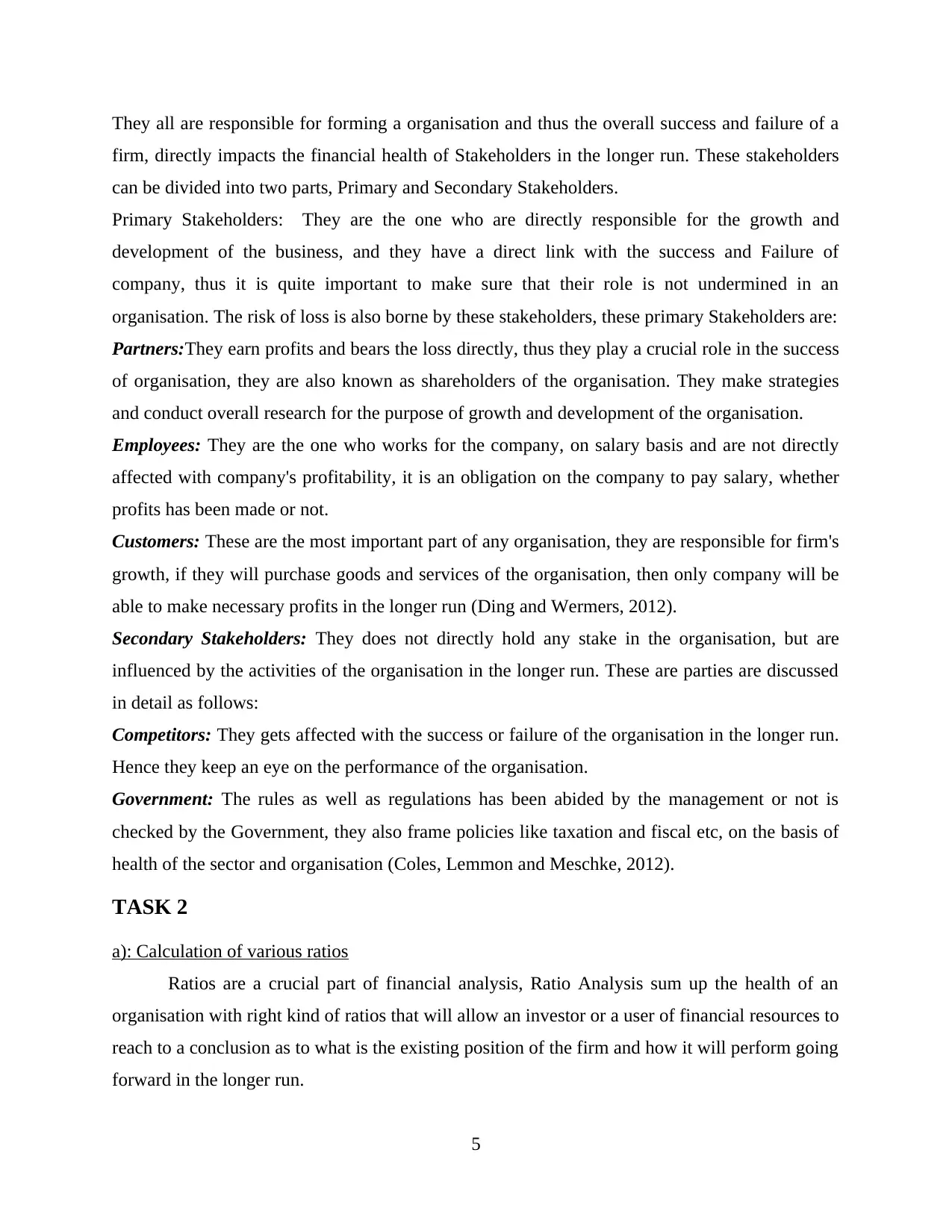
They all are responsible for forming a organisation and thus the overall success and failure of a
firm, directly impacts the financial health of Stakeholders in the longer run. These stakeholders
can be divided into two parts, Primary and Secondary Stakeholders.
Primary Stakeholders: They are the one who are directly responsible for the growth and
development of the business, and they have a direct link with the success and Failure of
company, thus it is quite important to make sure that their role is not undermined in an
organisation. The risk of loss is also borne by these stakeholders, these primary Stakeholders are:
Partners:They earn profits and bears the loss directly, thus they play a crucial role in the success
of organisation, they are also known as shareholders of the organisation. They make strategies
and conduct overall research for the purpose of growth and development of the organisation.
Employees: They are the one who works for the company, on salary basis and are not directly
affected with company's profitability, it is an obligation on the company to pay salary, whether
profits has been made or not.
Customers: These are the most important part of any organisation, they are responsible for firm's
growth, if they will purchase goods and services of the organisation, then only company will be
able to make necessary profits in the longer run (Ding and Wermers, 2012).
Secondary Stakeholders: They does not directly hold any stake in the organisation, but are
influenced by the activities of the organisation in the longer run. These are parties are discussed
in detail as follows:
Competitors: They gets affected with the success or failure of the organisation in the longer run.
Hence they keep an eye on the performance of the organisation.
Government: The rules as well as regulations has been abided by the management or not is
checked by the Government, they also frame policies like taxation and fiscal etc, on the basis of
health of the sector and organisation (Coles, Lemmon and Meschke, 2012).
TASK 2
a): Calculation of various ratios
Ratios are a crucial part of financial analysis, Ratio Analysis sum up the health of an
organisation with right kind of ratios that will allow an investor or a user of financial resources to
reach to a conclusion as to what is the existing position of the firm and how it will perform going
forward in the longer run.
5
firm, directly impacts the financial health of Stakeholders in the longer run. These stakeholders
can be divided into two parts, Primary and Secondary Stakeholders.
Primary Stakeholders: They are the one who are directly responsible for the growth and
development of the business, and they have a direct link with the success and Failure of
company, thus it is quite important to make sure that their role is not undermined in an
organisation. The risk of loss is also borne by these stakeholders, these primary Stakeholders are:
Partners:They earn profits and bears the loss directly, thus they play a crucial role in the success
of organisation, they are also known as shareholders of the organisation. They make strategies
and conduct overall research for the purpose of growth and development of the organisation.
Employees: They are the one who works for the company, on salary basis and are not directly
affected with company's profitability, it is an obligation on the company to pay salary, whether
profits has been made or not.
Customers: These are the most important part of any organisation, they are responsible for firm's
growth, if they will purchase goods and services of the organisation, then only company will be
able to make necessary profits in the longer run (Ding and Wermers, 2012).
Secondary Stakeholders: They does not directly hold any stake in the organisation, but are
influenced by the activities of the organisation in the longer run. These are parties are discussed
in detail as follows:
Competitors: They gets affected with the success or failure of the organisation in the longer run.
Hence they keep an eye on the performance of the organisation.
Government: The rules as well as regulations has been abided by the management or not is
checked by the Government, they also frame policies like taxation and fiscal etc, on the basis of
health of the sector and organisation (Coles, Lemmon and Meschke, 2012).
TASK 2
a): Calculation of various ratios
Ratios are a crucial part of financial analysis, Ratio Analysis sum up the health of an
organisation with right kind of ratios that will allow an investor or a user of financial resources to
reach to a conclusion as to what is the existing position of the firm and how it will perform going
forward in the longer run.
5
Paraphrase This Document
Need a fresh take? Get an instant paraphrase of this document with our AI Paraphraser
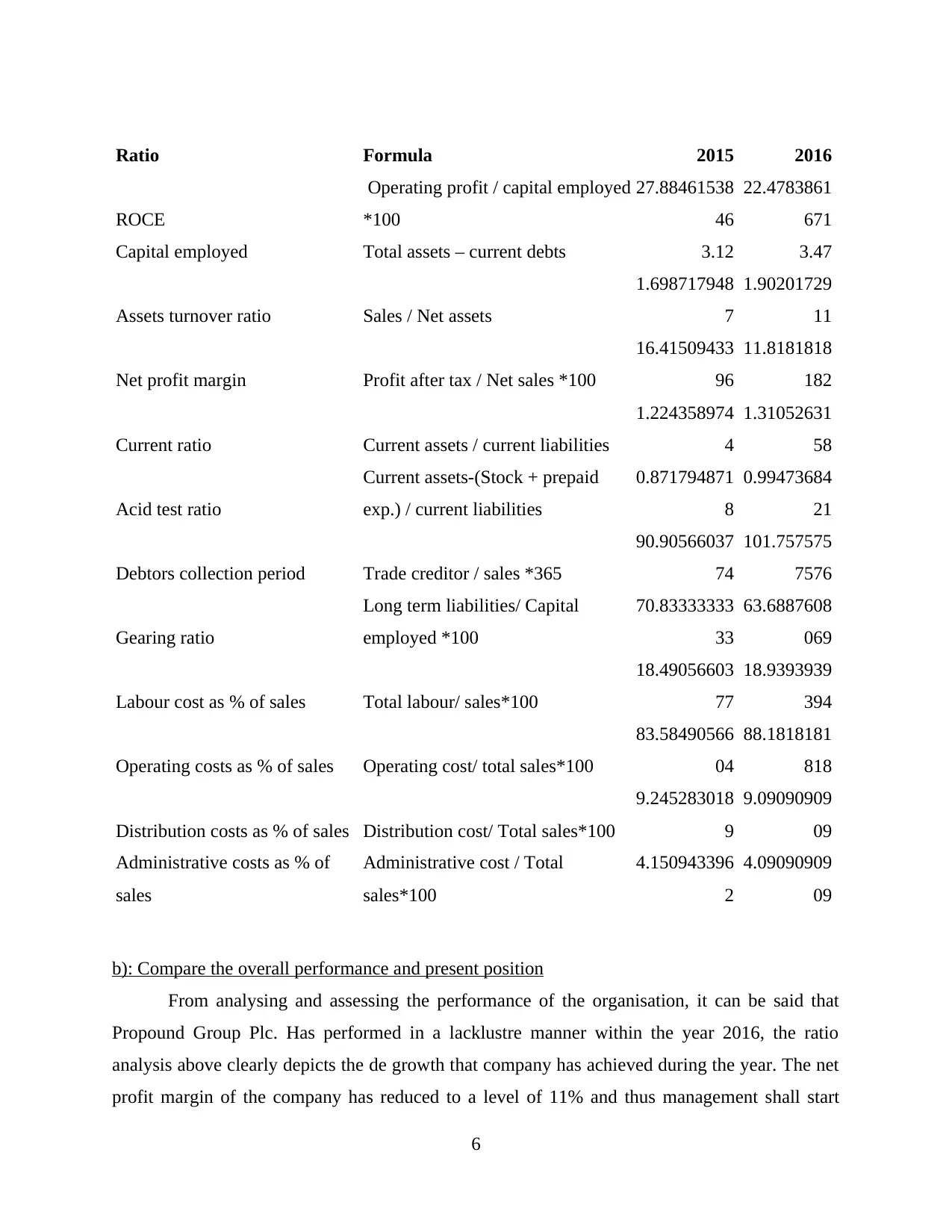
Ratio Formula 2015 2016
ROCE
Operating profit / capital employed
*100
27.88461538
46
22.4783861
671
Capital employed Total assets – current debts 3.12 3.47
Assets turnover ratio Sales / Net assets
1.698717948
7
1.90201729
11
Net profit margin Profit after tax / Net sales *100
16.41509433
96
11.8181818
182
Current ratio Current assets / current liabilities
1.224358974
4
1.31052631
58
Acid test ratio
Current assets-(Stock + prepaid
exp.) / current liabilities
0.871794871
8
0.99473684
21
Debtors collection period Trade creditor / sales *365
90.90566037
74
101.757575
7576
Gearing ratio
Long term liabilities/ Capital
employed *100
70.83333333
33
63.6887608
069
Labour cost as % of sales Total labour/ sales*100
18.49056603
77
18.9393939
394
Operating costs as % of sales Operating cost/ total sales*100
83.58490566
04
88.1818181
818
Distribution costs as % of sales Distribution cost/ Total sales*100
9.245283018
9
9.09090909
09
Administrative costs as % of
sales
Administrative cost / Total
sales*100
4.150943396
2
4.09090909
09
b): Compare the overall performance and present position
From analysing and assessing the performance of the organisation, it can be said that
Propound Group Plc. Has performed in a lacklustre manner within the year 2016, the ratio
analysis above clearly depicts the de growth that company has achieved during the year. The net
profit margin of the company has reduced to a level of 11% and thus management shall start
6
ROCE
Operating profit / capital employed
*100
27.88461538
46
22.4783861
671
Capital employed Total assets – current debts 3.12 3.47
Assets turnover ratio Sales / Net assets
1.698717948
7
1.90201729
11
Net profit margin Profit after tax / Net sales *100
16.41509433
96
11.8181818
182
Current ratio Current assets / current liabilities
1.224358974
4
1.31052631
58
Acid test ratio
Current assets-(Stock + prepaid
exp.) / current liabilities
0.871794871
8
0.99473684
21
Debtors collection period Trade creditor / sales *365
90.90566037
74
101.757575
7576
Gearing ratio
Long term liabilities/ Capital
employed *100
70.83333333
33
63.6887608
069
Labour cost as % of sales Total labour/ sales*100
18.49056603
77
18.9393939
394
Operating costs as % of sales Operating cost/ total sales*100
83.58490566
04
88.1818181
818
Distribution costs as % of sales Distribution cost/ Total sales*100
9.245283018
9
9.09090909
09
Administrative costs as % of
sales
Administrative cost / Total
sales*100
4.150943396
2
4.09090909
09
b): Compare the overall performance and present position
From analysing and assessing the performance of the organisation, it can be said that
Propound Group Plc. Has performed in a lacklustre manner within the year 2016, the ratio
analysis above clearly depicts the de growth that company has achieved during the year. The net
profit margin of the company has reduced to a level of 11% and thus management shall start
6
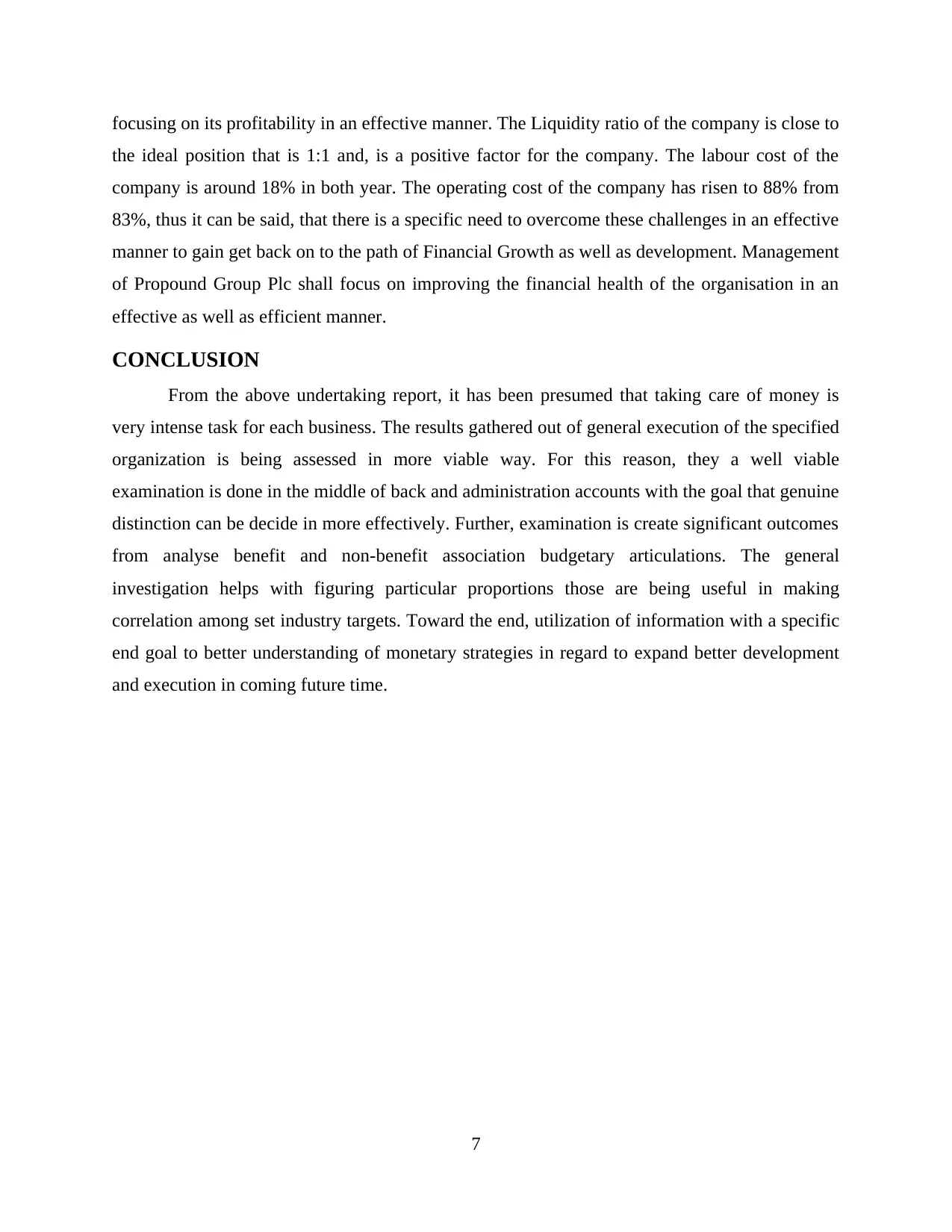
focusing on its profitability in an effective manner. The Liquidity ratio of the company is close to
the ideal position that is 1:1 and, is a positive factor for the company. The labour cost of the
company is around 18% in both year. The operating cost of the company has risen to 88% from
83%, thus it can be said, that there is a specific need to overcome these challenges in an effective
manner to gain get back on to the path of Financial Growth as well as development. Management
of Propound Group Plc shall focus on improving the financial health of the organisation in an
effective as well as efficient manner.
CONCLUSION
From the above undertaking report, it has been presumed that taking care of money is
very intense task for each business. The results gathered out of general execution of the specified
organization is being assessed in more viable way. For this reason, they a well viable
examination is done in the middle of back and administration accounts with the goal that genuine
distinction can be decide in more effectively. Further, examination is create significant outcomes
from analyse benefit and non-benefit association budgetary articulations. The general
investigation helps with figuring particular proportions those are being useful in making
correlation among set industry targets. Toward the end, utilization of information with a specific
end goal to better understanding of monetary strategies in regard to expand better development
and execution in coming future time.
7
the ideal position that is 1:1 and, is a positive factor for the company. The labour cost of the
company is around 18% in both year. The operating cost of the company has risen to 88% from
83%, thus it can be said, that there is a specific need to overcome these challenges in an effective
manner to gain get back on to the path of Financial Growth as well as development. Management
of Propound Group Plc shall focus on improving the financial health of the organisation in an
effective as well as efficient manner.
CONCLUSION
From the above undertaking report, it has been presumed that taking care of money is
very intense task for each business. The results gathered out of general execution of the specified
organization is being assessed in more viable way. For this reason, they a well viable
examination is done in the middle of back and administration accounts with the goal that genuine
distinction can be decide in more effectively. Further, examination is create significant outcomes
from analyse benefit and non-benefit association budgetary articulations. The general
investigation helps with figuring particular proportions those are being useful in making
correlation among set industry targets. Toward the end, utilization of information with a specific
end goal to better understanding of monetary strategies in regard to expand better development
and execution in coming future time.
7
⊘ This is a preview!⊘
Do you want full access?
Subscribe today to unlock all pages.

Trusted by 1+ million students worldwide
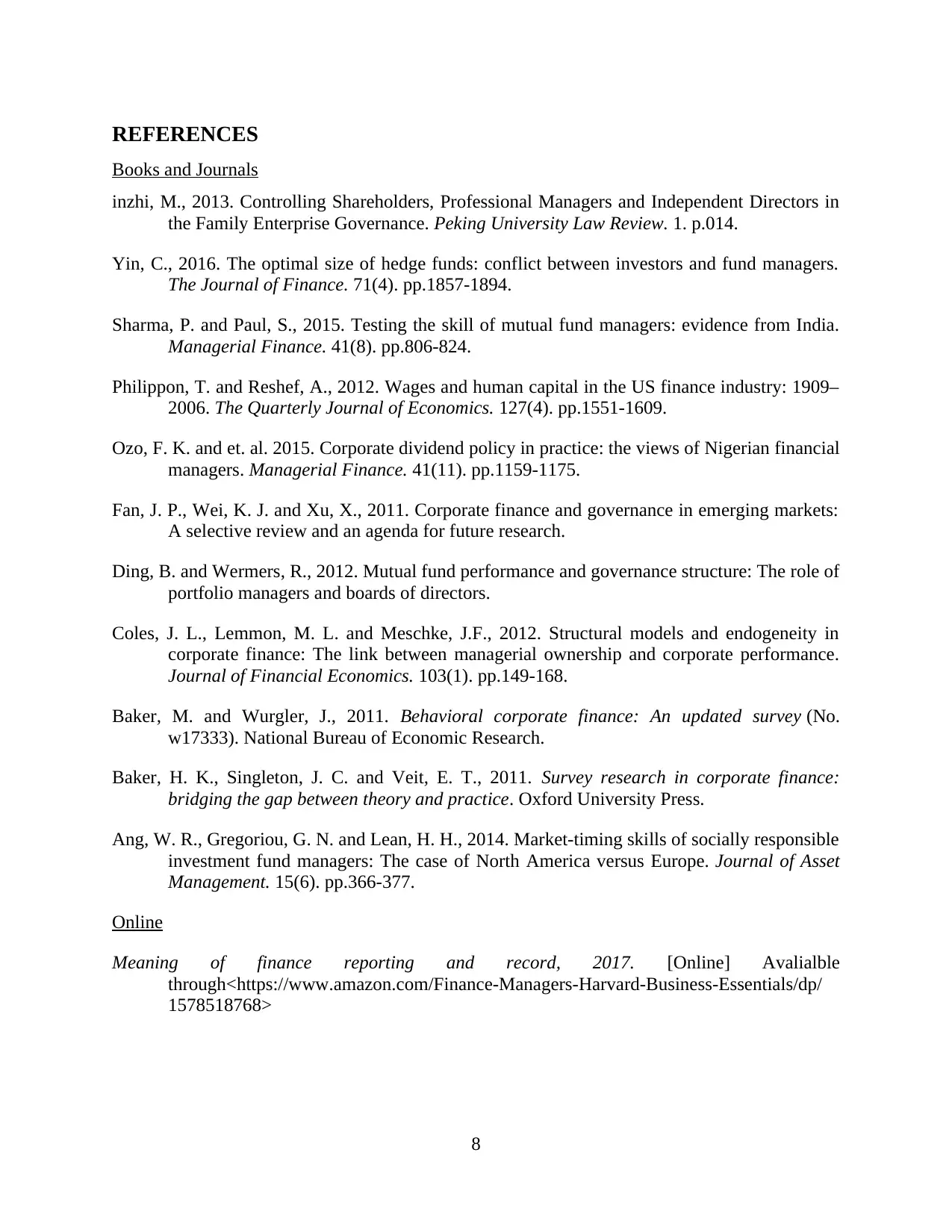
REFERENCES
Books and Journals
inzhi, M., 2013. Controlling Shareholders, Professional Managers and Independent Directors in
the Family Enterprise Governance. Peking University Law Review. 1. p.014.
Yin, C., 2016. The optimal size of hedge funds: conflict between investors and fund managers.
The Journal of Finance. 71(4). pp.1857-1894.
Sharma, P. and Paul, S., 2015. Testing the skill of mutual fund managers: evidence from India.
Managerial Finance. 41(8). pp.806-824.
Philippon, T. and Reshef, A., 2012. Wages and human capital in the US finance industry: 1909–
2006. The Quarterly Journal of Economics. 127(4). pp.1551-1609.
Ozo, F. K. and et. al. 2015. Corporate dividend policy in practice: the views of Nigerian financial
managers. Managerial Finance. 41(11). pp.1159-1175.
Fan, J. P., Wei, K. J. and Xu, X., 2011. Corporate finance and governance in emerging markets:
A selective review and an agenda for future research.
Ding, B. and Wermers, R., 2012. Mutual fund performance and governance structure: The role of
portfolio managers and boards of directors.
Coles, J. L., Lemmon, M. L. and Meschke, J.F., 2012. Structural models and endogeneity in
corporate finance: The link between managerial ownership and corporate performance.
Journal of Financial Economics. 103(1). pp.149-168.
Baker, M. and Wurgler, J., 2011. Behavioral corporate finance: An updated survey (No.
w17333). National Bureau of Economic Research.
Baker, H. K., Singleton, J. C. and Veit, E. T., 2011. Survey research in corporate finance:
bridging the gap between theory and practice. Oxford University Press.
Ang, W. R., Gregoriou, G. N. and Lean, H. H., 2014. Market-timing skills of socially responsible
investment fund managers: The case of North America versus Europe. Journal of Asset
Management. 15(6). pp.366-377.
Online
Meaning of finance reporting and record, 2017. [Online] Avalialble
through<https://www.amazon.com/Finance-Managers-Harvard-Business-Essentials/dp/
1578518768>
8
Books and Journals
inzhi, M., 2013. Controlling Shareholders, Professional Managers and Independent Directors in
the Family Enterprise Governance. Peking University Law Review. 1. p.014.
Yin, C., 2016. The optimal size of hedge funds: conflict between investors and fund managers.
The Journal of Finance. 71(4). pp.1857-1894.
Sharma, P. and Paul, S., 2015. Testing the skill of mutual fund managers: evidence from India.
Managerial Finance. 41(8). pp.806-824.
Philippon, T. and Reshef, A., 2012. Wages and human capital in the US finance industry: 1909–
2006. The Quarterly Journal of Economics. 127(4). pp.1551-1609.
Ozo, F. K. and et. al. 2015. Corporate dividend policy in practice: the views of Nigerian financial
managers. Managerial Finance. 41(11). pp.1159-1175.
Fan, J. P., Wei, K. J. and Xu, X., 2011. Corporate finance and governance in emerging markets:
A selective review and an agenda for future research.
Ding, B. and Wermers, R., 2012. Mutual fund performance and governance structure: The role of
portfolio managers and boards of directors.
Coles, J. L., Lemmon, M. L. and Meschke, J.F., 2012. Structural models and endogeneity in
corporate finance: The link between managerial ownership and corporate performance.
Journal of Financial Economics. 103(1). pp.149-168.
Baker, M. and Wurgler, J., 2011. Behavioral corporate finance: An updated survey (No.
w17333). National Bureau of Economic Research.
Baker, H. K., Singleton, J. C. and Veit, E. T., 2011. Survey research in corporate finance:
bridging the gap between theory and practice. Oxford University Press.
Ang, W. R., Gregoriou, G. N. and Lean, H. H., 2014. Market-timing skills of socially responsible
investment fund managers: The case of North America versus Europe. Journal of Asset
Management. 15(6). pp.366-377.
Online
Meaning of finance reporting and record, 2017. [Online] Avalialble
through<https://www.amazon.com/Finance-Managers-Harvard-Business-Essentials/dp/
1578518768>
8
1 out of 10
Related Documents
Your All-in-One AI-Powered Toolkit for Academic Success.
+13062052269
info@desklib.com
Available 24*7 on WhatsApp / Email
![[object Object]](/_next/static/media/star-bottom.7253800d.svg)
Unlock your academic potential
Copyright © 2020–2025 A2Z Services. All Rights Reserved. Developed and managed by ZUCOL.





